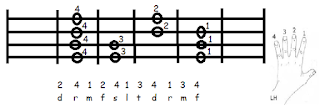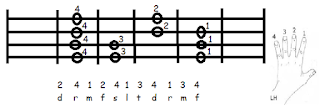Ever wondered where to find your notes on the bass guitar? Use the major scale as a reference point. By the major scale I mean “d r m f s l t d” or “C D E F G A B C”. Now how do you play that on the bass guitar. Watch
this video tutorial to get a better understanding. If you can’t watch the video, use the diagrams below the video.
Diagram of playing the major scale on a four-stringed bass guitar from the fourth string
Diagram of playing the major scale on a four-stringed bass guitar from the third string









